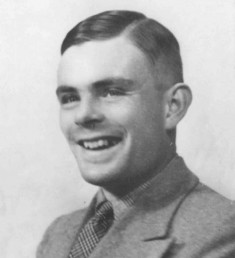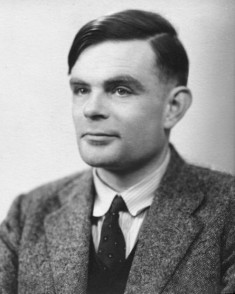Alan Turing is not the most recognized of the legendary mathematicians in history, but he is among the most important. If it were not for Turing, computer science as we know it might not exist.
His innovative work in the development of the Turing Machine eventually led to insights in algorithms and computation, which lie at the core of modern computing. The Turing Machine itself can be considered one of the very early machines that set the stage for the all-purpose general computer.
Early Years
Alan Turing was born on June 23, 1912, in London, England. His father worked for the Indian Civil Service (ICS) and this led to his frequent traveling to British India. The elder Turing wanted his children to stay in London so Alan and his brother lived with a retired army couple during much of their childhood.
Even as a very young man, Turing showed tremendous academic promise. He went on to attend St. Michael’s Day School starting at the age of six. His instructors noticed he was an exceptionally bright young man and encouraged his pursuit of academic excellence.
As a teen he went on to enroll in the Sherborne School and then he entered higher education at King’s College, Cambridge. His achievements at the college were so pronounced that he made a fellow by the age of 22.
College Work
On Computable Numbers, with an Application to the Entscheidungsproblem was a stunning paper he wrote while he was in college. The focus of the paper was on the limits of proof and computation found in Kurt Gödel’s 1931 results. Within the paper written by Turing, it was noted that formal and simple hypothetical devices would be the best replacement for the universal arithmetic-based formal language found in the Gödel concept.
From these new language insights, the Turing machines would eventually emerge.
Turing’s Work during WWII
 Alan Turing was also an expert at cracking codes and his skills were put to use for the British and Allied forces during the Second World War. The Polish had created a means of cracking codes, but there were problems with the method they employed. As a result, the Germans were capable of changing the codes when they found out they were being cracked.
Alan Turing was also an expert at cracking codes and his skills were put to use for the British and Allied forces during the Second World War. The Polish had created a means of cracking codes, but there were problems with the method they employed. As a result, the Germans were capable of changing the codes when they found out they were being cracked.
Turing believed (correctly) that mathematics could play a major role in cracking codes. He wrote papers centered on the notion that both statistics and probability both aided in deciphering coded messages. He also focused heavily on Enigma rotors since these were used significantly to encrypt enigma messages.
The Turing-Welchman Bombe
Eventually, Turing devised a machine that would once and for all crack Enigma related codes. He did not work alone on this project and had quite a bit of help from Gordon Welchman, a mathematician who also specialized in code breaking. The two devised the Turing–Welchman bombe, which was an electromechanical device that effectively cracked the Enigma code. The end result was a machine fully capable of helping the British overcome numerous hurdles and roadblocks related to figuring out German codes.
Turing would also go on to help the armed forces break the code of the German Naval Enigma, which was a much more difficult code to break. Without Turing, the ability for British intelligence to prosecute the war would have been extremely difficult.
Post-WWII Work
When the Second World War ended, Turing continued to live and work in London. He invested a significant amount of time working on early computer systems. Specifically, he invested a great deal of time on the Automatic Computing Engine (ACE). In the middle of the 1940s, he produced a paper that discussed the concept of the stored-program computer and the work was many years ahead of its time.
In the late 1940s, he joined the staff at the University of Manchester where he served as the Reader at the Mathematics Department. In 1949, he was promoted to the position of Deputy Director of the Computing Laboratory. During this time, he worked on the software for the Manchester Mark I, one of the very first stored-program computers ever devised.
Turing’s Strange Death
On June 8, 1954, Alan Turing was found dead. He died after eating a cyanide-laced apple. He seemed be to recreating a scene out of one of his favorite stories – Snow White and the Seven Dwarfs.
